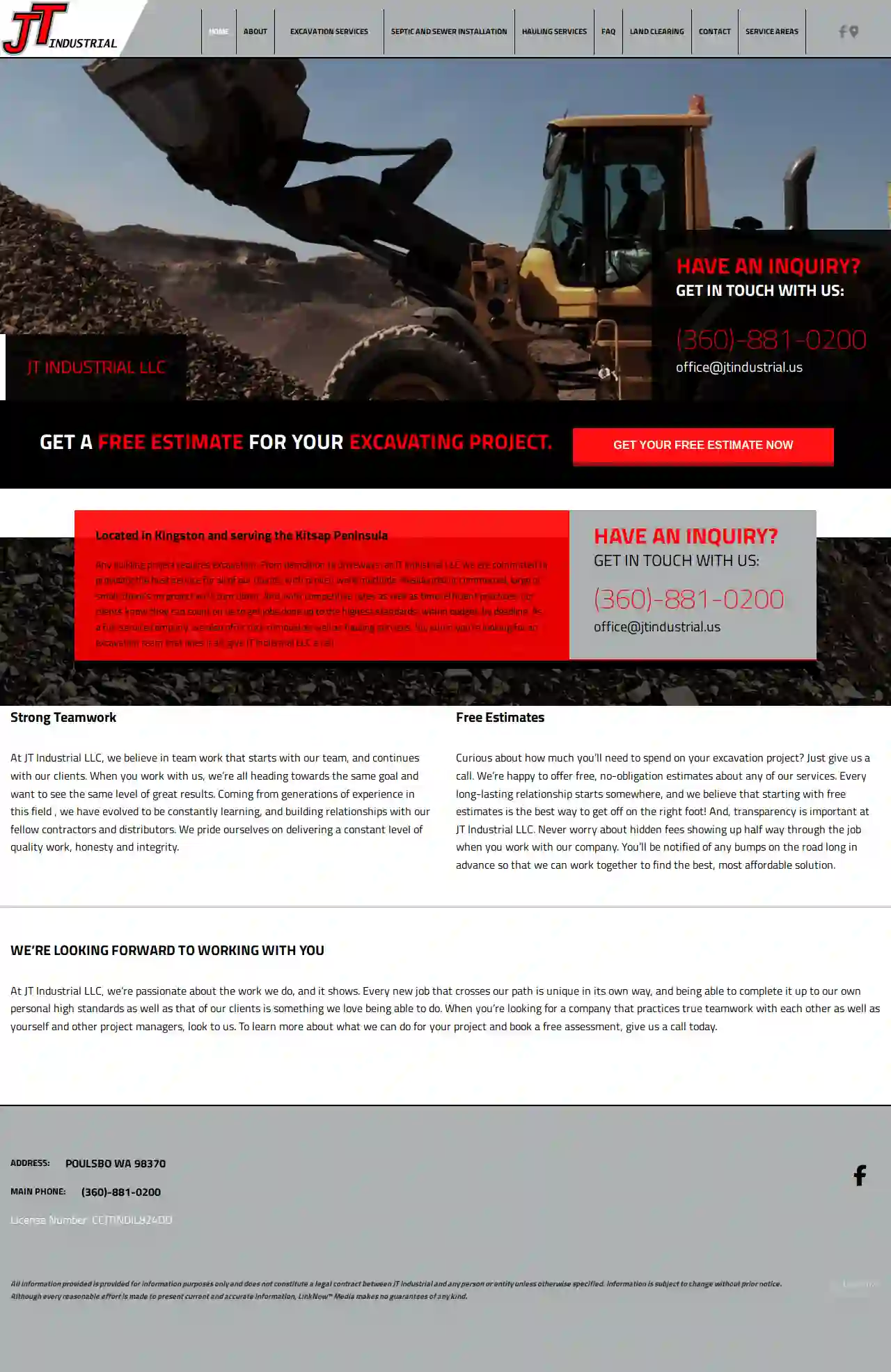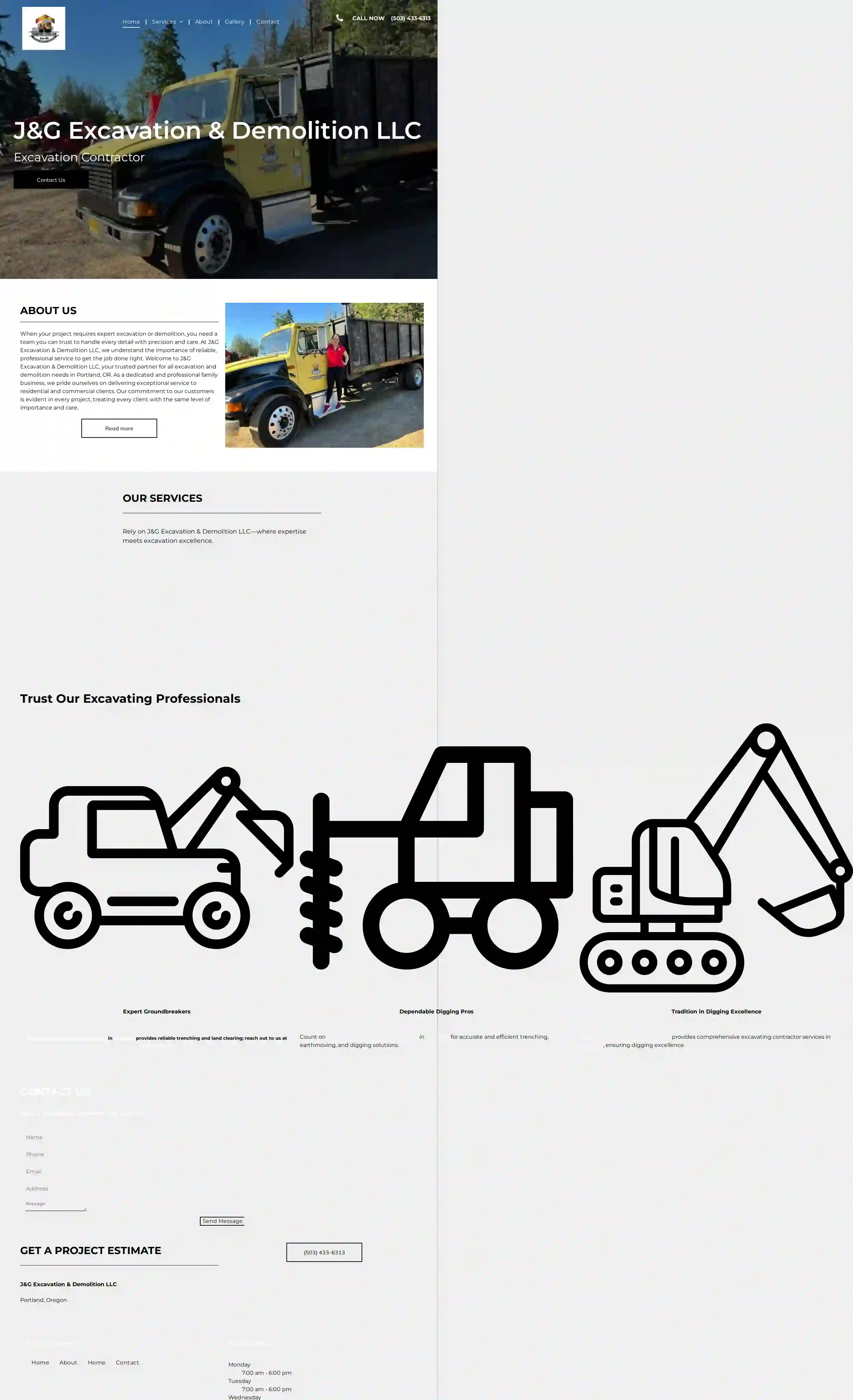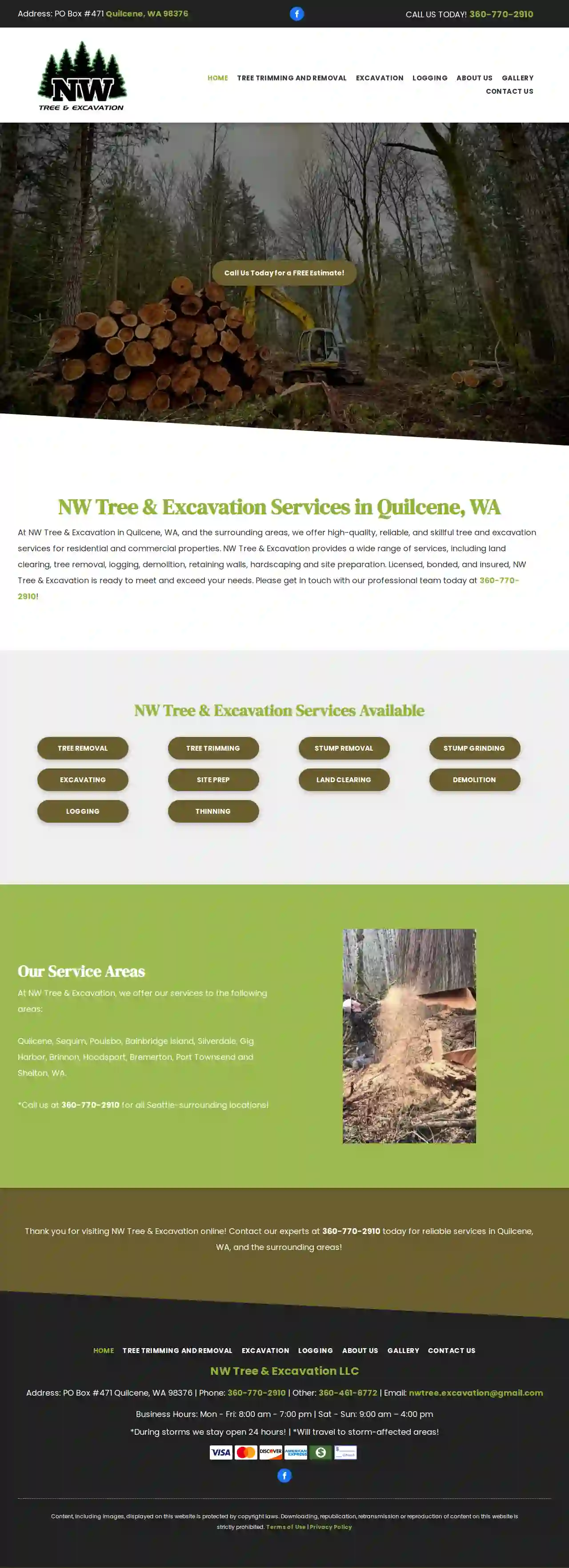Excavation Contractors Kenmore
Find the best Land Excavation in Kenmore
Get multiple Excavation Contractor quotes for your project today! Compare profiles, reviews, accreditations, portfolio, etc... and choose the best deal.

Straight Up Excavation and Drainage
525 reviews1341 Bay St Ste 130, Port Orchard, 98366, USExpert Excavation Services for Sustainable Property Development Straight Up Excavation and Drainage (previously Straight Up Tractor Services) is proud to offer quality Land Management Services to local home owners and business owners in the Kitsap County, Mason County and Gig Harbor, Washington area. Our experienced professionals have the necessary training and expertise to perform excavation, site preparation, land clearing, trenching and related services with high-quality craftsmanship. Call Straight Up Excavation and Drainage to discuss your next land management project today!
- Services
- Why Us?
- Gallery
Get Quote
Goodwin Dirt Works LLC
53 reviewsAirway Heights, USEFFICIENT. RELIABLE. EXCEPTIONAL. COMPETENCY. SAFETY. QUALITY. CUSTOMER SATISFACTION
- Services
- Why Us?
- Testimonials
- Gallery
Get Quote
Spaeth Transfer
4.6139 reviews1229 Hollis Street, Bremerton, 98310, USSpaeth Transfer: Your Trusted Bremerton Moving Company Spaeth Transfer, an Allied Van Lines agent, is your premier choice for professional moving and storage services in Bremerton, WA, and the surrounding areas. We've been serving the Greater Puget Sound area, the Olympic and Kitsap Peninsulas for years, building a reputation for reliability, expertise, and customer satisfaction. Whether you're moving locally, across the state, or internationally, our team of experienced movers is dedicated to making your relocation smooth and stress-free. We offer a comprehensive range of services, including packing, custom crating, storage, and home staging, tailored to meet your specific needs. We understand that your belongings are precious, and we treat them with the utmost care. Our movers are highly trained and experienced in handling everything from delicate antiques to heavy furniture, ensuring safe and efficient transportation. As a testament to our commitment to excellence, we offer free moving estimates. We'll come to your home, assess your needs, and provide you with an accurate quote. Contact us today at (360) 200-5041 to learn more about how we can help you move with ease.
- Services
- Why Us?
- Gallery
Get Quote
JT Industrial LLC
8202 NE State Hwy 104, #102-278, Poulsbo WA, Kingston, 98370, USJT Industrial LLC: Your Trusted Excavation Partner JT Industrial LLC is your go-to excavation company for all your construction needs on the Kitsap Peninsula. We specialize in a wide range of services, from demolition and driveways to rock removal and hauling. Whether you're a homeowner or a commercial developer, we're committed to providing exceptional service and delivering projects to the highest standards, on time and within budget. Our team brings generations of experience and a dedication to continuous learning. We believe in strong teamwork, not just within our company but also with our clients and fellow contractors. We strive for transparency and honesty, offering free, no-obligation estimates to ensure you're fully informed about your project costs. At JT Industrial LLC, we're passionate about what we do. Every project is unique, and we take pride in delivering results that exceed expectations. If you're looking for a reliable and experienced excavation team that values teamwork and integrity, look no further. Contact us today for a free assessment and let us help you bring your vision to life.
- Services
- Why Us?
- Gallery
Get Quote
Compton Builders | Asphalt Paving | Roofing Company
4.726 reviews1919 4th Avenue South, Seattle, 98134, USCompton Builders – Your Reliable Choice Redefine Your Space with Compton Builders Discover the Magic of Renovated Homes in Seattle Seattle Builders Specialist Builders in all construction projects From basic roof leaks, standard paving projects to complete rebuilds. We are here to help! We are an extension of Compton Lumber family that has been building Seattle for over 125 years. Compton Builders of Seattle Here at Compton Builders, we have decades of experience working on world-class projects in commercial, industrial, residential areas, and city road projects. For any project, big or small – remodeling to new builds, bring it to life with our local Seattle, WA Builders. We do everything from re-roofing your house to minor in-home repairs and high-rise buildings. Yes, our construction and building services are extensive! Family-owned and operated, we are an extension of the Compton Lumber and Hardware family.
- Services
- Why Us?
- Gallery
Get Quote
J&G Excavation & Demolition LLC
56 reviews555 SE Martin Luther King Jr Blvd Suite 105, Portland, 97214, USIntroducing J&G Excavation & Demolition LLC When your project requires expert excavation or demolition, you need a team you can trust to handle every detail with precision and care. At J&G Excavation & Demolition LLC, we understand the importance of reliable, professional service to get the job done right. Welcome to J&G Excavation & Demolition LLC, your trusted partner for all excavation and demolition needs in Portland, OR. As a dedicated and professional family business, we pride ourselves on delivering exceptional service to residential and commercial clients. Our commitment to our customers is evident in every project, treating every client with the same level of importance and care. At J&G Excavation & Demolition LLC, we offer a comprehensive range of services tailored to meet the diverse needs of our clients. Our excavation services cover everything from site clearing and preparation to specialized tasks like grading, regrading, and resloping. We ensure that your construction site is perfectly prepped for any building project, whether it involves constructing new foundations or installing essential systems such as septic tanks and French drains. Our demolition services are second to none, providing safe and efficient land demolition, building demolition, and construction demolition. We utilize top-of-the-line equipment, including Bobcats, to handle projects of any size with precision and care. Our team is also skilled in shoring services, ensuring that your site remains stable and secure throughout the demolition process. One of our standout offerings is the installation of retaining walls, essential for managing soil erosion and creating level areas in your landscape. Additionally, our site preparation services ensure that every aspect of your project is well planned and executed, from the initial clearing to the final grading. What sets J&G Excavation & Demolition LLC apart is our unwavering dedication to quality work, friendly service, and reasonable prices. Whether you need excavation, site preparation, or demolition services in Portland, OR, J&G Excavation & Demolition LLC is here to help. Our team is fully licensed and insured, giving you peace of mind knowing that your project is in capable hands. Contact us today to discuss your project and discover how we can bring your vision to life. We look forward to working with you and making your project our priority.
- Services
- Why Us?
- Gallery
Get Quote
Kalin Excavating
4.649 reviewsSpokane, USTrenchless Sewer & Water The go-to choice for residential and commercial clients Your Go-To Choice With over 30 years of experience, Kalin has become a trusted name in the industry for installing sewer and water lines in Spokane and the surrounding region. Expertise when and where it counts Knowledge & Experience Over 30 years solving problems specific to Spokane and the surrounding region Leading the way in the latest sewer technology Highly trained crews and technicians Family owned and operated Traditional Excavation and Trenchless The Right Tools for the Job As a superior alternative to pipe bursting, lining has become the preferred choice for Spokane homeowners. In response to this demand, we expanded our lining capabilities by introducing the latest lining technology in the summer of 2023. This state-of-the-art equipment enables us to line pipes from the basement and offers enhanced flexibility in re-lining a wider variety of pipes.
- Services
- Why Us?
- Testimonials
- Gallery
Get Quote
Swope Excavation
4.88 reviews1000 Swope Parkway, Kansas City, 64152, USAbout Swope Excavation Swope Excavation is a family-owned and operated business serving the greater Kansas City area. We have been providing quality excavation services for over 20 years. Our team of experienced professionals is dedicated to providing our clients with the highest level of service and workmanship. We are committed to safety, quality, and customer satisfaction. We offer a wide range of excavation services, including: Site preparation Grading Demolition Utility installation And more! We are fully insured and bonded, and we are committed to providing our clients with the peace of mind that comes with knowing that their project is in good hands. Contact us today for a free estimate.
- Services
- Why Us?
- Testimonials
Get Quote
NW Tree & Excavation LLC
513 reviewsPO Box #471, Quilcene, 98376, USNW Tree & Excavation: Your Trusted Partner for Tree and Excavation Services in Quilcene, WA At NW Tree & Excavation in Quilcene, WA, and the surrounding areas, we offer high-quality, reliable, and skillful tree and excavation services for residential and commercial properties. We are committed to providing exceptional service and exceeding your expectations. Our team of experienced professionals is dedicated to delivering safe and efficient solutions for all your tree and excavation needs. Whether you require tree removal, land clearing, stump grinding, or site preparation, we have the expertise and equipment to handle any project, big or small. We understand the importance of preserving the natural beauty of your property. That's why we use environmentally friendly practices and strive to minimize disruption during our operations. Contact us today for a free estimate and let us help you transform your property into the outdoor oasis you've always dreamed of.
- Services
- Why Us?
- Gallery
Get Quote
Sewer Solutions NW
4.941 reviewsSeattle, USSEATTLE'S TRENCHLESS PIPE REPAIR EXPERT The team at Sewer Solutions NW knows what it takes to get the job done — and how to get it done well. With more than 30 years in the industry, we have the experience necessary to keep your home or business sewers in top condition. Call us and find out how to get a FREE estimate. SEWER SOLUTIONS NORTHWEST Sewer Solutions NW is a licensed, bonded, and insured second-generation utility company, doing business in the greater Seattle area for over 30 years. We specialize in many sewer pipe repair services, such as pipe bursting, epoxy liner, sewer camera inspection hydro jetting, and excavation. We’re committed to being a one-stop-shop for the construction industry, handling projects from start to finish on time, and on (or under) budget. Our combination of experience, knowledge, and specialized equipment guarantee superior results, and we’re known for our exceptional employee training, job site safety, and full insurance. Call or email us for an assessment of your job, and don’t forget to check our special online offers. Read more about us
- Services
- Why Us?
- Testimonials
- Gallery
Get Quote
Over 22,076+ Excavation Businesses onboarded
Our excavation contractors operate in Kenmore and surroundings!
ExcavationHQ has curated and vetted the Best Excavation Contractors in Kenmore. Find the most trustworthy business today.
Frequently Asked Questions About Excavation Contractors
- Mechanical Excavation: Utilizing heavy equipment like excavators, backhoes, bulldozers, and loaders, suitable for most projects.
- Hand Excavation: Using hand tools (shovels, picks) for smaller excavations or delicate work near utilities.
- Blasting: Employing explosives to break up rock or hard materials, typically for large-scale projects.
- Hydro Excavation: Using high-pressure water jets to loosen and remove soil, often used for locating utilities or delicate excavation.
- Vacuum Excavation: Employing a vacuum system to suck up excavated material, suitable for safe excavation near utilities or in confined spaces.
- Topsoil Removal: Stripping the fertile topsoil layer from a site, often preserving it for landscaping.
- Trench Excavation: Digging long, narrow trenches for utilities (pipes, cables) or foundations.
- Basement Excavation: Removing earth to create a space for a basement beneath a structure.
- Pool Excavation: Digging a precise hole for installing a swimming pool.
- Roadway Excavation: Removing earth and preparing the ground for road construction.
- Demolition Excavation: Clearing debris and preparing the site after demolition.
- Channel Excavation: Creating channels for drainage or irrigation.
- Utility Locates: Contact your utility companies to mark the locations of underground lines before excavation begins. This is usually a free service.
- Hand Digging: Excavate carefully by hand near marked utility lines to avoid damage.
- Potholing: Digging small test holes to expose and verify utility depths and locations.
- Safe Distances: Maintaining a safe distance between excavation equipment and marked utility lines.
- Vacuum Excavation: Using vacuum excavation techniques to expose utilities without digging, reducing the risk of damage.
- Clearly Define the Scope: Outline the project's goals, including the excavation area, depth, grade, and intended use.
- Obtain Necessary Permits: Research and acquire any required permits from your local authorities.
- Mark Utility Lines: Contact your utility companies to locate and mark underground utilities to prevent damage.
- Communicate with Neighbors: Inform your neighbors about the project's timeline and potential noise or disruptions.
- Prepare the Site: Clear any obstacles, such as vegetation, furniture, or structures, from the excavation area.
- Discuss Safety Protocols: Review safety procedures with the contractor to ensure a safe work environment.
What are the different methods of excavation?
What are the different types of excavation?
How do you protect utilities during excavation?
What should I do before excavation starts?
What are the different methods of excavation?
- Mechanical Excavation: Utilizing heavy equipment like excavators, backhoes, bulldozers, and loaders, suitable for most projects.
- Hand Excavation: Using hand tools (shovels, picks) for smaller excavations or delicate work near utilities.
- Blasting: Employing explosives to break up rock or hard materials, typically for large-scale projects.
- Hydro Excavation: Using high-pressure water jets to loosen and remove soil, often used for locating utilities or delicate excavation.
- Vacuum Excavation: Employing a vacuum system to suck up excavated material, suitable for safe excavation near utilities or in confined spaces.
What are the different types of excavation?
- Topsoil Removal: Stripping the fertile topsoil layer from a site, often preserving it for landscaping.
- Trench Excavation: Digging long, narrow trenches for utilities (pipes, cables) or foundations.
- Basement Excavation: Removing earth to create a space for a basement beneath a structure.
- Pool Excavation: Digging a precise hole for installing a swimming pool.
- Roadway Excavation: Removing earth and preparing the ground for road construction.
- Demolition Excavation: Clearing debris and preparing the site after demolition.
- Channel Excavation: Creating channels for drainage or irrigation.
How do you protect utilities during excavation?
- Utility Locates: Contact your utility companies to mark the locations of underground lines before excavation begins. This is usually a free service.
- Hand Digging: Excavate carefully by hand near marked utility lines to avoid damage.
- Potholing: Digging small test holes to expose and verify utility depths and locations.
- Safe Distances: Maintaining a safe distance between excavation equipment and marked utility lines.
- Vacuum Excavation: Using vacuum excavation techniques to expose utilities without digging, reducing the risk of damage.
What should I do before excavation starts?
- Clearly Define the Scope: Outline the project's goals, including the excavation area, depth, grade, and intended use.
- Obtain Necessary Permits: Research and acquire any required permits from your local authorities.
- Mark Utility Lines: Contact your utility companies to locate and mark underground utilities to prevent damage.
- Communicate with Neighbors: Inform your neighbors about the project's timeline and potential noise or disruptions.
- Prepare the Site: Clear any obstacles, such as vegetation, furniture, or structures, from the excavation area.
- Discuss Safety Protocols: Review safety procedures with the contractor to ensure a safe work environment.